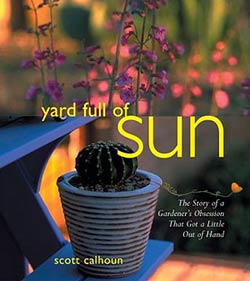 A Book Review by Paula Panich
A Book Review by Paula Panich
Yard Full of Sun:
The Story of a Gardener’s Obsession
That Got a Little Out of Hand
by Scott Calhoun
Rio Nuevo Publishers, 2005 (www.rionuevo.com)
Lavishly illustrated with gorgeous photographs
$22.95
Buy this book. Read this book. Read it even if you live in USDA Zone 3, 4, or 5 and have never seen a Chihuahuan orchid shrub (Bauhinia lunaroides) or a Texas violet sage (Salvia farinacea) and your summer yard has only a thimbleful of sun.
Why should you read this book? Here are five reasons:
1. Because John Muir said you should.
2. Because Scott Calhoun is full of passion, good will, and knowledge.
3. Because his voice on the page is a river of bright water.
4. See number two.
5. See number three.
So what does John Muir (d. 1914) have to do with a young horticulturist building a 21st-century home and garden on the far east side of Tucson? It’s because John Muir points out:
“When we try to pick out anything by itself, we find in hitched to everything else in the universe.”
I will admit to some exasperation with gardeners who seem closed to the idea of reading or learning about plants outside their own cultivation zones. If the garden clog fits, get over it. This passionate plantsman and gardener has everything to do with you and the arisaemas pushing up in your barely unthawed shady Spring garden.
You’ve got to love Scott Calhoun’s passion, first of all. He gives us the whole story. He gardened in Utah, but yearned to return to his native Arizona with his young family. They read about a new residential development in the desert, Civano, which is rooted in desert and water conservation principles. They moved to a Tucson apartment in 1999, and planned their new adobe house and desert garden. The family’s three big ideas:
1. Celebrate native plants
2. Save water
3. Live outside
Calhoun’s story stays true to these three principles and to the many smaller ones that “orbited [around these] like moons around planets.”
He tells us about his influences (even Derek Jarman’s Dungeness garden), his search for plants and trees; the adventures and misadventures of construction; his hilarious tale of middle-of-the-night javalina repelling (his fly was open); how he used his collection of Mexican soda bottles as garden décor; how the family collects and recycles rain water; and how he, quite improbably to proper Yankees, rigged up an outdoor movie theater.
This gardener is in love with his world. Readers can’t help but to fall in love with it too. Calhoun is an engaging writer. He is very very good at the one or two line character sketch. It’s part of what makes this book irresistible. The “green” general contractor on the Calhoun house, David, drives a Chevy truck with “Zen” vanity plates. He listens to Jethro Tull, which is, he reminds Calhoun, “a band, not a guy.” Clouds cloud the Arizona skies, though, when another contractor and David have a falling out. David is “a one-eyed dog chasing a pork chop on a fishing pole,” the guy says to Calhoun. Nonetheless, peace is brokered; the secondary contractor becomes part of the team, and consequently, “quarts of Dewar’s became a kind of currency.”
Although the house is integral to the Calhoun saga — and wife Diedre and daughter Zoe are much loved continuing characters in the narrative — the plants and the yard full of sun really have center stage here. Calhoun writing about the trees, shrubs, and wildflowers he loves is a pleasure. He writes of the sweet acacia tree (Acacia farnesiana) and its “mysterious, dry sweet smell,” and that Jefferson grew it in a Monticello greenhouse to “enjoy its perfume.” He writes that “falling for a pink flower” was unusual for him, but now he is a certifiable penstemon nut. (You will be too, when you see the luscious photographs of Parry’s penstemon.) Oh he goes on, to the reader’s delight and desert plant education.
What makes all of this work — exquisite photographs, plant lists, charts, recipes, the reckoning of the volume of water dripping from the roof, nursery lists, gardens to visit, books to read — is that fresh, convincing, enthusiastic voice of an engaged human being, full of good will.
It’s not easy putting that fluid voice on the page. But Calhoun is no novice writer, or reader. The skillful text offers up the observations of many of the West’s finest writers — Edward Abbey, Terry Tempest Williams, Rick Bass, Charles Bowden, and Larry McMurtry, who calls the early morning light in Tucson “a river of bright air.” (Note to Mr. McMurtry: Sorry for the theft.) And Calhoun is conversant with gardeners and writers Rick Darke and Beth Chatto and others, who garden far away from the Sonoran Desert.
The Sonoran adobe “bungalow” the Calhouns built, by the way, is no multi-million dollar extravaganza. It’s a 1,580 square-foot house. Their budget was $110,000, excluding their patch of desert. Their garden is a joyous place of stunning plants, delight, and whimsy — and they accomplished what they set out to do. Day by day, they realize their three big ideas. They celebrate native plants, save water, and live outside, and I think you may want to hitch yourself to the spirit of this particular universe.
